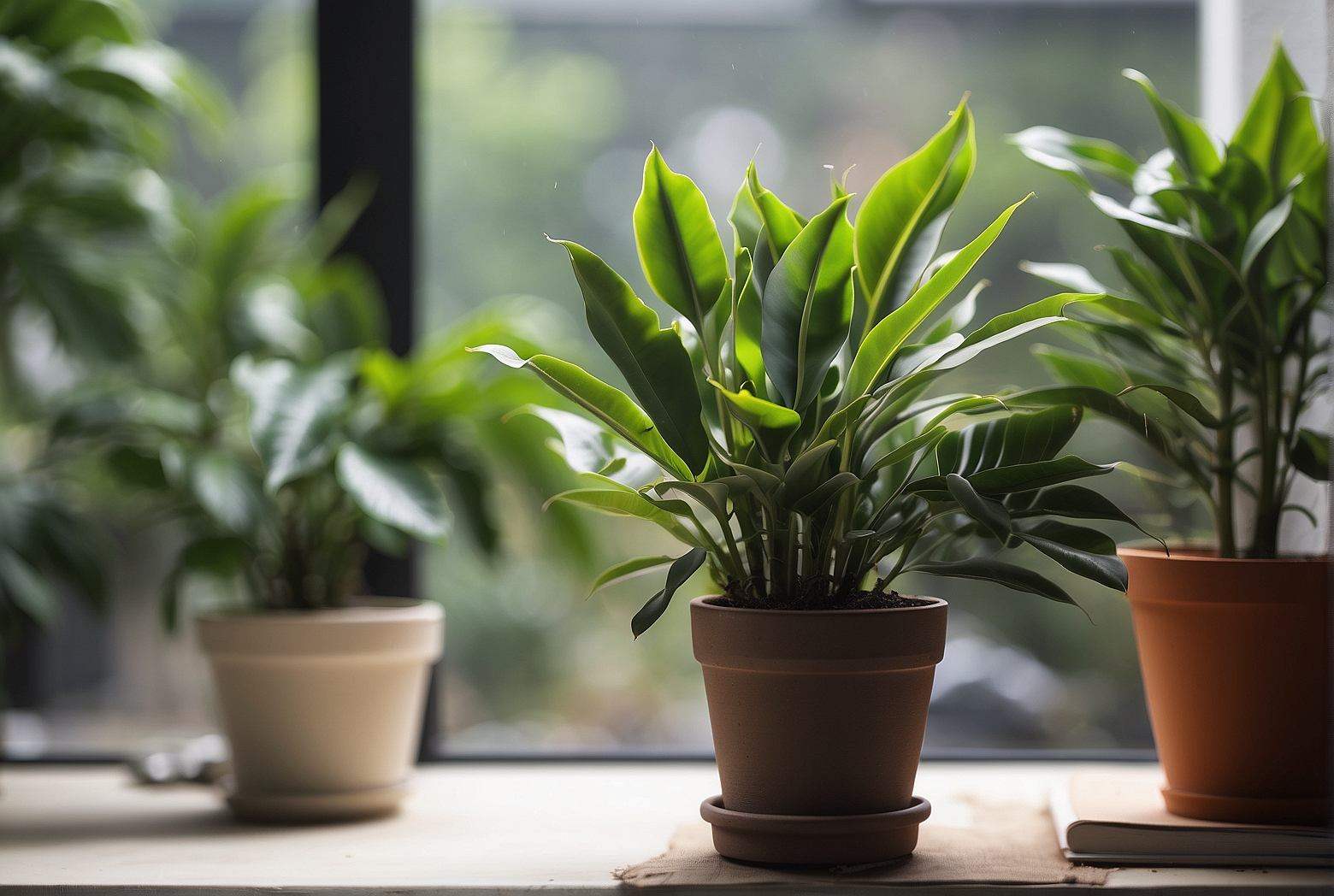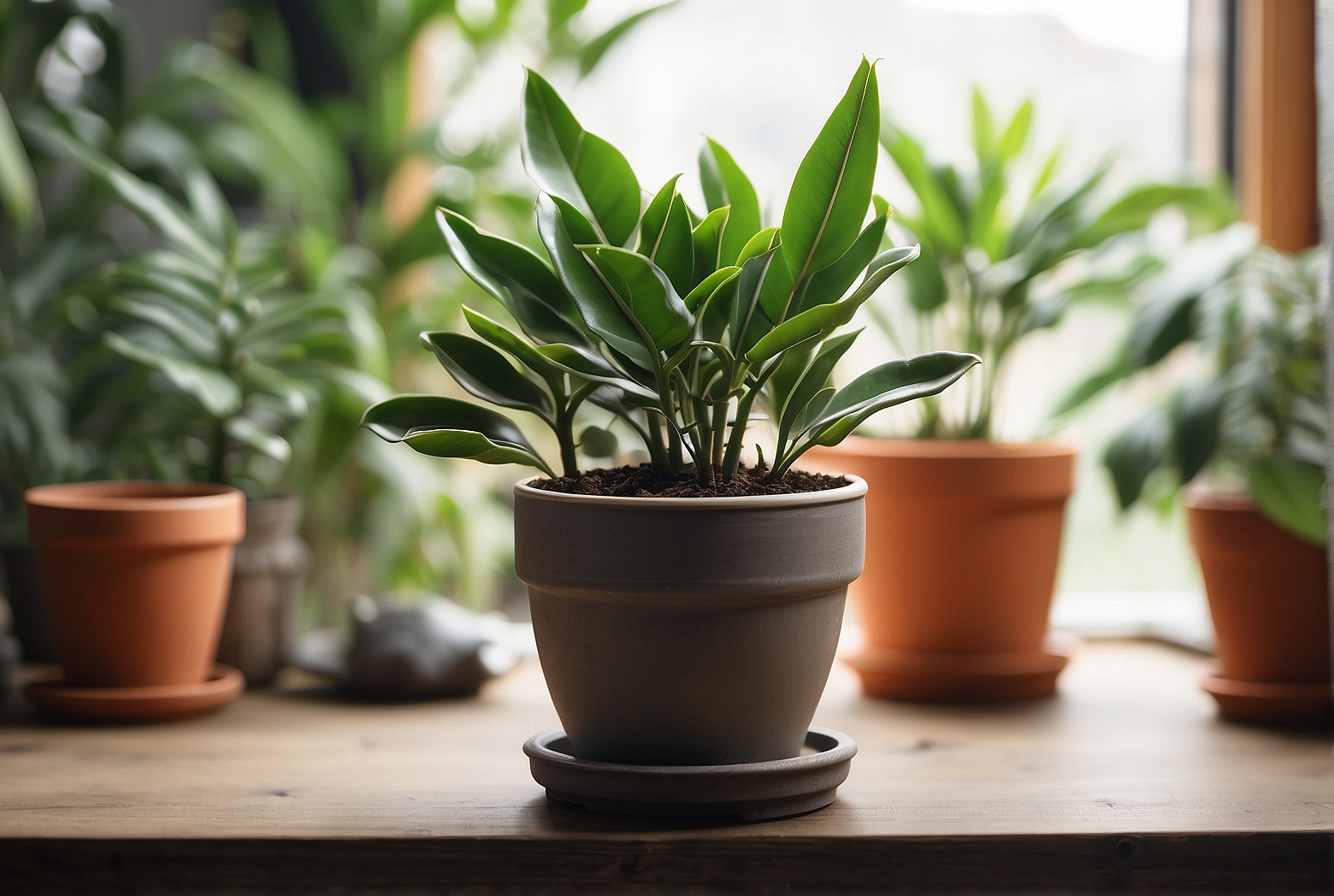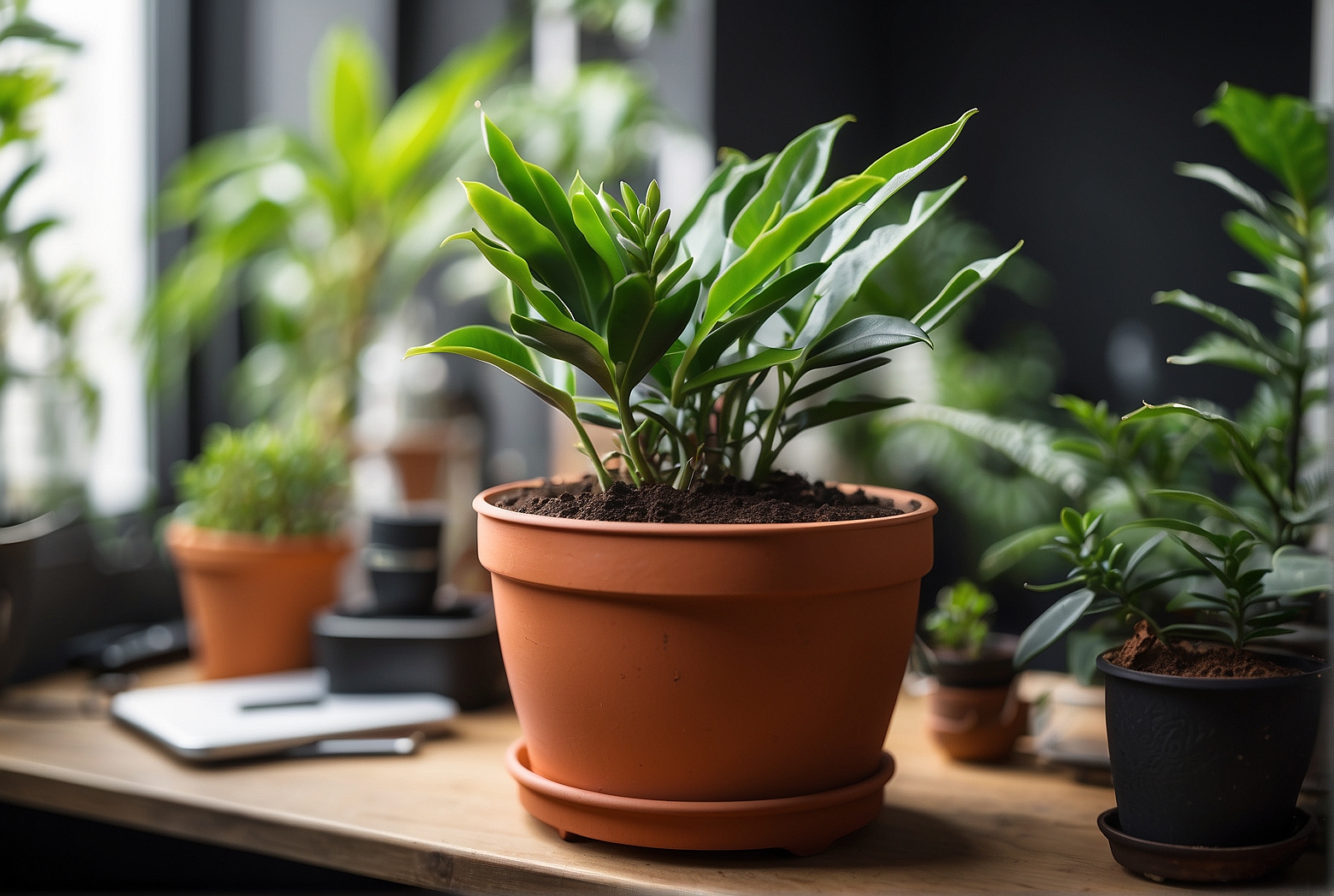Last Updated on April 8, 2024 by Tony Manhart
Looking to accelerate the growth of your ZZ plant? Look no further! In this article, you’ll find a collection of helpful tips and tricks that will aid you in your journey to promote faster and healthier growth in your beloved ZZ plant. Whether you’re a seasoned plant enthusiast or just starting out, these suggestions are sure to give your ZZ plant the boost it needs to thrive and flourish. So get ready to witness your plant transform before your eyes as you implement these tried-and-true methods for accelerating its growth.
Providing Optimal Growing Conditions
Choosing the right pot
When it comes to choosing the right pot for your ZZ plant, there are a few factors to consider. Opt for a pot that has drainage holes at the bottom to allow excess water to escape. This will prevent overwatering and root rot. Additionally, the pot should provide enough room for the plant to grow, but not be excessively large. A pot that is about 2 inches larger in diameter than the root ball is usually sufficient.
Using well-draining soil
Well-draining soil is essential for the health and growth of your ZZ plant. A mix of peat moss, perlite, and sand is a good option. This type of soil allows water to pass through easily, preventing waterlogging and ensuring the roots receive enough oxygen. Avoid heavy or clayey soil, as it retains water and can lead to root rot.
Ensuring adequate sunlight
ZZ plants thrive in bright indirect light, but they can also tolerate lower light conditions. Place your plant near a window that receives bright, filtered light. Avoid direct sunlight as it can scorch the leaves. If you don’t have access to natural light, artificial grow lights can be used to provide the necessary light intensity.

Maintaining optimal temperature
ZZ plants are native to tropical regions, so they prefer warm temperatures. Ideally, keep your plant in an environment where the temperature stays between 65°F and 75°F (18°C to 24°C). Avoid exposing your ZZ plant to extreme temperature fluctuations, drafts, or cold air from air conditioning or heating vents.
Providing appropriate humidity levels
ZZ plants are adaptable and can tolerate a range of humidity levels. However, they prefer moderate humidity. To increase humidity levels, you can place a tray of water near the plant or use a humidifier. Misting the leaves occasionally also helps to provide some moisture. Avoid placing your plant near dry air sources like heaters or vents.
Watering and Moisture
Understanding the watering needs
Proper watering is crucial for the health and growth of your ZZ plant. ZZ plants have thick, fleshy rhizomes that store water, so they prefer slightly drier conditions. It’s important to let the soil partially dry out between waterings to avoid overwatering.
Determining the frequency of watering
The frequency of watering your ZZ plant depends on various factors such as the size of the pot, the amount of light it receives, and the temperature and humidity levels in the environment. As a general guideline, water your ZZ plant when the top inch of the soil feels dry to the touch. Be cautious not to let the soil completely dry out or become too soggy.

Avoiding overwatering
Overwatering is one of the most common mistakes when caring for a ZZ plant. It can lead to root rot, yellowing leaves, and even the death of the plant. To avoid overwatering, always check the moisture level of the soil before watering and make sure to allow excess water to drain out of the pot.
Using the right watering techniques
When watering your ZZ plant, it’s best to water at the base of the plant, near the soil. This allows the water to reach the roots effectively. Avoid watering the leaves directly, as this can lead to fungal diseases. Use room temperature water to avoid shocking the roots with cold or hot water.
Misting or providing humidity trays
ZZ plants do not require high humidity levels, but misting the leaves occasionally can help increase humidity. Additionally, you can place a tray filled with pebbles and water underneath the pot to create a humid microclimate around the plant. However, be careful not to let the bottom of the pot sit in water, as this can lead to root rot.
Fertilizing and Nutrient Management
Choosing the right fertilizer
When it comes to fertilizing your ZZ plant, choose a balanced, water-soluble fertilizer specifically formulated for houseplants. Look for a fertilizer with a ratio of 10-10-10 or 20-20-20, which indicates the percentage of nitrogen, phosphorus, and potassium respectively. Alternatively, you can use a slow-release fertilizer to provide a constant supply of nutrients over time.
Understanding the nutrient requirements
ZZ plants have relatively low nutrient requirements. Nitrogen promotes leaf growth, phosphorus enhances root development, and potassium supports overall plant health. Follow the instructions on the fertilizer packaging to ensure you’re providing the appropriate amount of nutrients.
Establishing a fertilizing schedule
During the growing season, which typically spans from spring to summer, fertilize your ZZ plant once every 4 to 6 weeks. Reduce the frequency to once every 2 months during the fall and winter when the plant is in its dormant phase. Remember to always water the plant before applying fertilizer to prevent burning the roots.
Applying the fertilizer correctly
When applying fertilizer to your ZZ plant, dilute the fertilizer to half-strength or the recommended dosage. Overfertilizing can lead to nutrient burn, which causes yellowing and browning of the leaves. Apply the diluted fertilizer evenly to the soil around the plant, avoiding direct contact with the leaves.
Addressing nutrient deficiencies
If you notice signs of nutrient deficiencies in your ZZ plant, such as yellowing leaves, stunted growth, or poor overall health, consider adjusting your fertilizing routine. Increase the frequency or potency of the fertilizer, or switch to a fertilizer with a higher ratio of the deficient nutrient. Always monitor the plant’s response and make adjustments accordingly.
Pruning and Maintenance
Removing dead or yellowing leaves
Regularly inspect your ZZ plant for dead or yellowing leaves and remove them promptly. These leaves do not contribute to the plant’s growth and can become a breeding ground for pests and diseases. Use clean, sharp scissors or pruning shears to make clean cuts near the base of the leaf stem.
Trimming to maintain desired shape
If your ZZ plant becomes too large or loses its desired shape, you can trim it back. Use pruning shears or scissors to carefully remove the desired portion of the plant. Make sure to sanitize your tools before and after pruning to prevent the spread of diseases.
Pruning for better growth
Pruning can also be done to stimulate growth in your ZZ plant. By removing the tips of the stems, you can encourage the plant to produce new growth and become bushier. However, avoid excessive pruning, as ZZ plants have slow growth rates and may take longer to recover.
Removing pests or diseases
Regularly check your ZZ plant for pests such as mealybugs, spider mites, or aphids. If you spot any pests, remove them manually or use organic insecticidal soap to control their population. Additionally, promptly remove any diseased plant parts to prevent the spread of diseases.
Regular cleaning and dusting
Dust can accumulate on the leaves of your ZZ plant, hindering photosynthesis and creating an unsightly appearance. Wipe the leaves with a damp cloth or gently mist them to remove dust and keep the plant clean. This also helps to improve air circulation around the plant.
Propagating ZZ Plant
Understanding propagation methods
ZZ plants can be propagated through various methods such as stem cuttings, leaf cuttings, or division of the rhizomes. Stem cuttings are the most common method and usually produce the best results.
Choosing the appropriate propagation technique
For stem cuttings, select a healthy stem with a few leaves attached. Make a clean cut just below a node and remove the lower leaves. Leaf cuttings can also be taken by carefully removing a leaf from the stem and planting it in moist soil. Rhizome division involves separating the rhizomes with roots into individual plants.
Preparing the cuttings or divisions
Once you have obtained the cuttings or divisions, let them dry for a few hours to allow the cut end to callous over. This helps to prevent rotting when planted. If desired, you can dip the cut end in rooting hormone to promote faster root development.
Providing optimal conditions for propagation
Place the cuttings or divisions in a container with well-draining soil and moisten the soil. Cover the container with a plastic bag or use a propagation tray with a clear lid to create a humid environment. Position the container in a warm, bright location away from direct sunlight.
Caring for the new plants
Keep the soil consistently moist, but not soggy, during the propagation process. Mist the cuttings or divisions occasionally to maintain humidity. After a few weeks, you should start to see new growth. Once the new plants have established roots, they can be potted in individual pots following the same care guidelines for mature ZZ plants.
Managing Pests and Diseases
Identifying common pests
Common pests that can affect ZZ plants include mealybugs, spider mites, scale insects, and aphids. These pests can cause damage to the leaves, stems, and roots of the plant. Regularly check for any signs of infestation, such as stippling, webbing, or sticky residue on the plant.
Implementing preventive measures
Preventing pest infestations is key to maintaining the health of your ZZ plant. Inspect new plants before bringing them indoors to ensure they are not carrying any pests. Quarantine new plants for a few weeks and regularly monitor them for any signs of pests. Avoid overwatering, as this can attract pests.
Using organic or chemical treatments
If you notice a pest infestation on your ZZ plant, there are various treatment options available. For organic control, you can use insecticidal soap or neem oil spray to suffocate and kill the pests. Chemical treatments such as insecticides or miticides may also be used, but be sure to follow the instructions carefully.
Dealing with common diseases
Common diseases that can affect ZZ plants include root rot, stem rot, and fungal infections. These diseases are often caused by overwatering, poor drainage, or high humidity levels. To prevent diseases, ensure proper watering practices, use well-draining soil, and maintain good air circulation around the plant.
Taking prompt action for control
If your ZZ plant shows signs of disease, such as wilting, yellowing leaves, or blackened stems, take immediate action. Remove affected parts of the plant and treat with a fungicide if necessary. Adjust your watering routine and environmental conditions to prevent further disease spread.
Avoiding Common Mistakes
Overwatering
Overwatering is one of the most common mistakes made when caring for ZZ plants. Remember to allow the soil to partially dry out between waterings to avoid waterlogged conditions and root rot.
Insufficient light
ZZ plants require bright, indirect light to thrive. Ensure they are placed near a window that receives sufficient sunlight or provide artificial grow lights if natural light is limited.
Using wrong soil or pot
Using heavy or clayey soil can lead to poor drainage and root rot. Choose well-draining soil specifically formulated for houseplants. Additionally, select a pot with drainage holes to allow excess water to escape.
Neglecting cleanliness
Dust can accumulate on the leaves, hindering photosynthesis and attracting pests. Regularly clean the leaves of your ZZ plant to keep it healthy and pest-free.
Ignoring signs of stress or damage
Pay attention to your ZZ plant and notice any signs of stress, such as drooping leaves, yellowing, or brown spots. Promptly address these issues by adjusting care or addressing any underlying problems.
Providing Adequate Support
Using stakes or trellises for taller plants
For taller ZZ plants that may become top-heavy, providing support with stakes or trellises can help prevent them from leaning or falling over. Use soft twine or plant ties to secure the stems to the support structure.
Ensuring proper support for heavy foliage
ZZ plants with large, lush foliage may require extra support to prevent the stems from bending or breaking under the weight. Use plant stakes or hoops to support the foliage and maintain an upright position.
Tying or securing the plant when necessary
If your ZZ plant begins to lean or grow in a direction you don’t desire, gently tie or secure the stems to a support structure to redirect their growth. Be careful not to tie too tightly, as this can damage the plant.
Regularly checking and readjusting supports
Periodically check the supports for your ZZ plant to ensure they are still providing adequate support. Take note of any leaning or bending and readjust the supports as needed. This will help maintain the plant’s desired shape and prevent any potential damage.
Preventing damage due to falling or leaning
By providing proper support, you can prevent your ZZ plant from falling over or leaning excessively. This will help protect the plant from physical damage and ensure its long-term health and growth.
Monitoring and Adjusting Care
Observing plant health and growth
Regularly observe your ZZ plant for signs of healthy growth and overall well-being. Check for new growth, vibrant foliage, and general vitality. If any issues arise, address them promptly to prevent further decline.
Noticing signs of stress or deficiencies
Being attentive to signs of stress or nutrient deficiencies is essential for maintaining a healthy ZZ plant. Look for wilted leaves, yellowing, brown spots, or stunted growth. Take appropriate action to address the issue, such as adjusting watering or fertilizing routine.
Adjusting care based on seasonal changes
Seasonal changes can impact the care requirements of your ZZ plant. During the growing season, provide more frequent watering and fertilizing. In the dormant season, reduce watering and fertilizing to accommodate the plant’s natural resting period.
Taking action in response to plant behavior
Each ZZ plant is unique and may have different care needs. Pay attention to how your plant responds to various conditions and adjust your care accordingly. For example, if your plant shows signs of being root-bound, consider repotting it to provide more room for growth.
Keeping records for future reference
Maintaining records of your care routines and observations can be helpful for future reference. Note down watering and fertilizing schedules, changes in lighting conditions, and any adjustments made. This will help you establish an effective care routine and troubleshoot any issues that may arise.
Patience and Persistence
Understanding the natural growth rate
ZZ plants have a slow growth rate, so it’s important to have patience when expecting results. It may take time for your plant to grow larger or produce new shoots. Avoid overestimating the growth rate and remain consistent with your care routine.
Allowing time for the plant to acclimate
When introducing a new ZZ plant to your home, give it time to acclimate to its new environment. Sudden changes in temperature, lighting, or humidity can stress the plant. Be patient and allow the plant to adjust gradually.
Being patient with expected results
ZZ plants are known for their ability to thrive in different conditions, but they may not grow as quickly as other houseplants. Avoid becoming discouraged if your plant doesn’t grow as fast as you’d like. With proper care and patience, your ZZ plant will eventually flourish.
Continuing efforts for long-term growth
To ensure long-term growth and success with your ZZ plant, it’s important to continue providing consistent care and attention. Don’t be tempted to neglect your plant once it reaches your desired size. Ongoing efforts will help maintain its health and beauty.
Applying consistent care and attention
Consistency is key when caring for a ZZ plant. Treat your plant with the same level of care and attention throughout its life. From watering and fertilizing to providing optimal conditions, your plant will thrive with your dedicated efforts.
By following these comprehensive guidelines for providing optimal growing conditions, watering and moisture management, fertilizing and nutrient management, pruning and maintenance, propagating, managing pests and diseases, avoiding common mistakes, providing support, monitoring and adjusting care, and practicing patience and persistence, you’ll be well-equipped to accelerate the growth of your beloved ZZ plant. Remember, each ZZ plant is unique, so paying attention to its specific needs and adapting your care routine accordingly is essential in fostering a healthy and thriving plant. Enjoy the journey of nurturing your ZZ plant and witnessing its growth and beauty over time.
Tony Manhart is a passionate gardener who has been tending to gardens for over 20 years. He takes pride in creating beautiful outdoor spaces with plants, trees, and shrubs that can thrive in any environment. He loves to share his knowledge with others and has taught classes on gardening basics and advanced techniques. He is committed to sustainability, using natural and organic methods to create and maintain gardens. He also works with local organizations to create green spaces for communities. When he’s not gardening, Tony enjoys hiking, reading, and spending time with his family.


